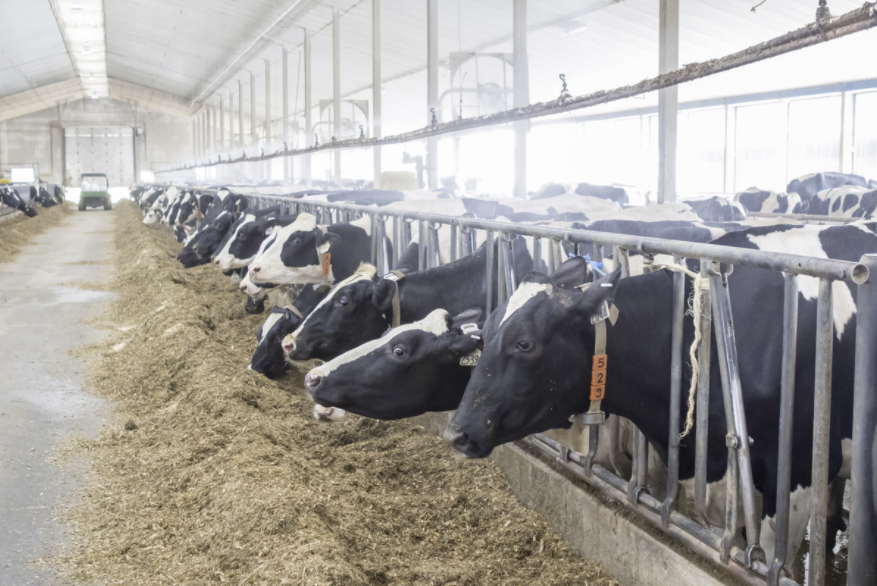Dairy cattle and other ruminants are biologically designed to convert a wide variety of forages and feeds that can’t be digested by humans into milk, a high-quality food and protein used by humans.
Many of these feeds that can be consumed by ruminants are byproducts of processing food for humans. Processing feed grains for human food creates soybean meal, canola meal, wheat midds, corn gluten meal and corn gluten feed. Food waste from manufacturing includes whey, bakery waste, brewers grain, distillers grain, citrus pulp, apple pomace, candy and chocolate. Fruits and vegetables from processing are also included as food waste.
Cattle can consume these waste co-products because of their unique rumen fermentation, where billons of bacteria, protozoa and fungi produce enzymes to use cellulose carbohydrates as a nutrient source. Since humans lack the enzymes needed to utilize cellulose in these co-products, if they were not fed to animals they would end up in landfills, be composted, used in anaerobic digesters or incinerated. Dr. Mike Van Amburgh of Cornell University determined that less carbon dioxide is released into the atmosphere when co-products are fed to animals instead of being incinerated. Workers in California estimate that dairy cows in the U.S. use up to 306 million pounds of food waste, including co-products, per day.
How much of the dairy cow’s diet consists of feeds not suitable for humans?
California workers have reported that typical dairy cattle diets contain 82% of the feed that is not suitable for human consumption. This includes forages, co-products and food waste. A nationwide survey of 350 dairy farms by the Innovation Center for U.S. Dairy found that the average diet fed contained 80% human inedible feeds.
We recently put together a database of 79 high-producing dairy herds and high-producing groups. These herds were mainly in the Northeast and Midwest, with an average of 110 pounds per day of energy-corrected milk (ECM). Figure 1 contains the proportion of the feed components in the average diet for these farms.

Forages and co-product feeds comprise 85% of the total diet. Figure 2 is a high-group diet from one farm averaging 105 pounds of ECM.

This farm also has 85% of the total diet from forages and co-product feeds but fed a higher level of forage and less co-product feeds. There were a couple of farms that had greater than 90% of the total diet as forage and co-product feeds. These farms fed home-produced, high-moisture corn and no dry corn grain.
What is the ratio of human edible food produced (HEP) to the quantity of human edible components (HEC) in the feed consumed by the cow?
Research in Sweden compared diets with cereal grains and soybean meal with diets that only contained co-product feeds. The ratio of HEP to HEC for the cereal grain diet was 0.73 on a protein basis. Less HEP was produced than consumed. Yet the ratio was 2.6 to 2.7 on the three co-product diets. More HEP was produced than consumed.
We conducted a trial in cooperation with Dr. Mary Beth Hall at the U.S. Dairy Forage Research Center to examine this question. This was a year when many dairy producers had limited forage supplies and corn and soybean prices were high. The diet fed before the trial was 61% forage and contained corn and soybean meal. The trial diets were 40% forage. Beet pulp, corn gluten feed, distillers grain and whole cottonseed were used to replace corn and soybean meal. A small amount of chopped wheat straw was included to ensure adequate chewing, rumination and rumen pH. Late-lactation cows were used and produced 79 pounds of ECM with 4.3% milkfat and 3.2 milk true protein. Milk production was 80 pounds of ECM on the diet fed before the trial. The ratio of HEP to HEC in our trial was 2.3. These cows produced more HEP than consumed when fed co-products.
Co-product feeds and food waste can be divided into two groups based on dry matter content. Most of these used in dairy cattle ration are dry feeds. These are used by feed manufacturers and available as individual commodities that can be purchased for on-farm use. Some companies also provide blends of food wastes. Examples are bakery co-product, candy meal and chocolate meal. Nutritionists use a variety of these when formulating protein and energy mixes.
Several wet co-products or food wastes are also used on New York dairy farms. The most common are wet brewers grain, wet distillers grain and liquid whey. Table 1 contains average composition of wet brewers and distiller grains.

As with any feed ingredient, there are differences in nutrient composition based on the specific plant and process used to produce these feeds. It is essential to obtain nutrient composition data from the plant producing the co-product as base for developing feeding programs and assessing economic value of the co-product. A key consideration in using wet co-products is the short shelf life. This requires balancing feed use rates with the quantity and frequency of feed deliveries.
Summary
- Dairy cattle produce high-quality and nutritious milk from a variety of forages and feeds.
- Many dairy rations contain 80% or more of the total ration as forages and feeds that are not directly consumable by humans.
- The quantity of human edible protein produced by the dairy cow is higher than the amount of human edible protein consumed in rations when co-products and food wastes are included in the ration.
- Knowing the nutrient composition of food wastes fed to dairy cattle is critical for optimum use in diets.










